BY PAUL BELASIK
Judging by my mailbox, dressage riders seem perplexed about how competition judges are currently evaluating some horses’ piaffes at the international level. What is high quality and what is faulty? In this article, I will address two major faults in piaffes of popular riders that have appeared in recent performances, and seem to be confusing viewers.
The piaffe is a movement or exercise that is part of an evolving mastery of collection, the longitudinal field of balance. Collection is a process where the horse redistributes its weight more towards the rear, lightening the forehand. The haunches lower and step under, so the hocks are always in front of a perpendicular line drawn from the point of the buttocks to the ground (the hocks should not be buried in the tail.) The hind feet usually widen slightly, as a weight lifter would widen his or her stance when about to lift a serious weight. Historically, the piaffe was often used as a precursor to airs above the ground. When the forehand is completely lifted off the ground in a movement like levade, it becomes proof of the continuous process of collection. This process can start with simple exercises, including trot-halt transitions, to engage and strengthen the hind end.
It has been my contention that when modern competition outlawed airs above the ground, it inadvertently set the stage for many misrepresentations and mistakes in the piaffe that we are seeing today. Even if one never does any airs above the ground, all dressage aficionados should understand their governing principles.
Pics taken at a performance of the Royal Portuguese School in Jerez
For example, collection should not be misconstrued with rhythm. Just as vibrato is a quality of music or voice, it is useless if the singer is off key. Rhythm is a quality of collection, but is useless window dressing if the balance is incorrect and there is not shifting of weight, or “sitting.” When there is no demonstration of this longitudinal mastery, a crucial element of dressage is missing.
I’ve added some photos and descriptions to try to clarify the qualities of a good piaffe and good collection, versus some incorrect forms.
TRIANGULATION IN PIAFFE
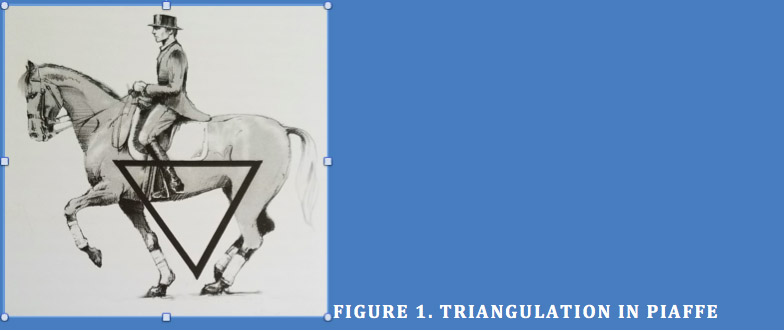
FIGURE 1. TRIANGULATION IN PIAFFE
This is probably one of the most common problems with the piaffe. Older trainers refer colloquially to triangulation as a piaffe that resembles an ‘elephant on a stool.’ The horse’s legs crowd toward each other as if they were trying to balance on a point (Figure 1.) The legs form two sides of a triangle and the back, the third side. The interesting thing about horses that triangulate in the piaffe is that they are almost universally well engaged behind. A brief look at the hindquarters and the piaffe seems to reveal a piaffe of high quality. The haunches are often deep set, with the legs well under. Why then, would the horse’s forelegs begin to creep and slant backwards? The answer is that they are trying to move toward the center of gravity to get under the weight and therefore carry it. Whenever the forelegs begin to creep back, the trainer has to be suspicious no matter how good the haunches look. The hind legs are not carrying weight and are missing the premier requirement of the piaffe.
story continues below the advertisement
Oddly enough, horses usually triangulate in the piaffe when the rider tries too hard for engagement. If the hindquarters are forced too far under the horse, they can get so cramped that they cannot help in the lift. If they become too stressed, especially in learning the movement, the horse’s body will compensate. If the hind legs cannot hold up the weight, the forelegs will help. I have already mentioned that master after master has warned of the need to let the piaffe move forward. Ignoring this advice contributes to triangulation, and adding forward motion helps to cure it. When the hind legs are so cramped that they cannot extend, they almost float. Without being grounded, the back and hind end have nothing to lever against. The front legs are doing all the work. One of the signs of this is that the piaffe will stall: the horse has redistributed weight off the hindquarters and is caught falsely in place without drive.
Allowing the piaffe to move forward calls the hind legs back into play. They can often now push and carry weight, to relieve the shoulders of some of the weight.
BALANCÉ
FIGURE 2. BALANCÉ
This is a fault both in piaffe and passage. Although it is caused by improper collection, I don’t feel it is because a horse is lazy or not trying. In most cases, it is the opposite. The horse is trying too hard, but incorrectly. The horse tries to give the rider more suspension and cadence, but since the core is weak and the hind legs are not carrying the load and are therefore unable to lift the forehand up, the forelegs try to do it. Even though the forelegs are not really constructed as limbs of thrust, they are still capable of it. In the case of balancé, the horse pushes off with one foreleg and although this gives the shoulders some lift, it also pushes them to the side. At that point, the other forelimb steps away from the body to stop the push and initiates a push of its own. The result is a kind of tennis match of energy (Figure 2). The center of gravity is volleyed back and forth from one foreleg to the other. (Remember, the widening of the stance of a set of limbs is a tip-off that they are trying to do more work.) The core must be strengthened to prevent this axial twist or roll.
story continues below the advertisement
TRANSITIONS FROM PIAFFE TO PASSAGE
Here you can see the change of weight with the haunches lowering and coming under at the transition from passage to piaffe. Remember though, you cannot really evaluate these movements without seeing this movement from the front and back.
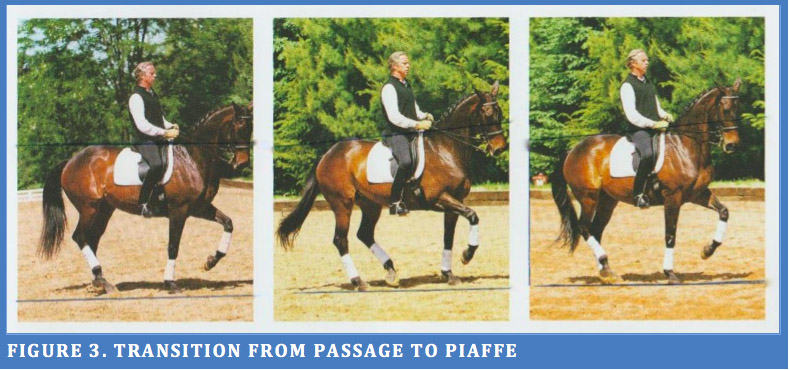
The piaffe is a natural evolution of collecting the trot, so in a sense it is the most collected trot. As in the trot, the diagonal pairs of limbs have the same swing time but unlike the trot, there is asymmetry and no suspension phase. The forefeet and legs are asked to travel higher, at least twice as high as the hind feet and legs. This is possible because the object of the exercise is to move the hind legs further up under the center of balance. If this transference is accomplished, the forelegs and forehand will be lighter, freer, and able to move faster.
Historically, a very important use of the piaffe was as a preparation for jumps or airs above the ground. The horse could be asked to gradually coil its hind end under. The trainer then adjusted the piaffe so the setup, the balance, and the lightening of the forehand could be made just before the singular, sometimes explosive effort of a jump. Today, at some of the historic schools in the world, one can still see horses vigorously engaged in piaffe just before the set up to a levade, capriole or courbette. These piaffes, made honest by the requirements of jumping off the hind legs, are of the highest quality. Jumping out of the piaffe is so accurate a proof that one can use it in reverse to judge the quality of one’s own piaffe. All that the rider has to ask is ‘could the horse levade out of this piaffe?’ and the answer will be an indication of whether the balance is correct.
The piaffe should not have lateral deviations. If the horse’s limbs begin to travel too far away from their normal way of going, it is usually a signal that there are fundamental problems of strength and balance interfering with the horse’s ability to balance itself in that higher collection. If the core of the horse is not strong, it cannot control the thrust off of one or the other legs, and that unilateral thrust will twist the horse.
Although the piaffe should not have any lateral movement (swaying or rocking, for example) it has always been allowed a little longitudinal or forward movement. In fact, except at the highest, finished levels (and even then only for short intervals), in most practice situations it should move forward. Allowing the piaffe to move gives the hind legs more chance to come up under, but also to extend and then flex again. This can avoid the hind legs cramping, which can happen if the trainer overzealously forces them too far under, turning the engagement false. In such cases, the forelegs invariably step in to carry the load because the hind legs cannot. When a piaffe is held on the spot, it is most vulnerable to evasions. Without the purifying elixir of natural, complete cycles of muscular movement (albeit very short ones) throughout the ‘ring of muscle’, it is easy for the limbs to develop unnatural patterns. So, while it is true that an already schooled piaffe can be ‘polished’ by working on the spot in pillars, for example, it can also be ruined that way.
Current German co-coach, Jonny Hilberath and Wenckstern
As the horse makes a transition into piaffe, it steps forward into the movement with its hind legs. The rider never pulls on the reins to try to force the horse backwards, but forms a passive hand, which dams up the increased energy. As the hind legs gradually step under and the back contracts, the psoas and iliopsoas and gluteal muscles help to tip the hindquarters under and lift the forehand. The horse’s back is now firm and rounded, and the neck is also extended as the whole spine curves up into a ‘C’-shaped bow. The base of the neck raises up, and the underside contracts. This is why in some of the old photographs when the rider shows extreme collection in the piaffe, the underside of the horse’s neck will look ‘pigeon throated,’ or puffed out. A perfunctory glance from an uneducated eye assumes the horse to be hollow when in fact, the deeply set haunches lift a back as strong as the deck of a drawbridge. The mid-section of the horse is completely connected. The horse’s body is one muscular whole. The rider’s back and the horse’s back are welded together in a kind of cross. Following the balance of the rider, this solid cross is either tipped upward or lowered.
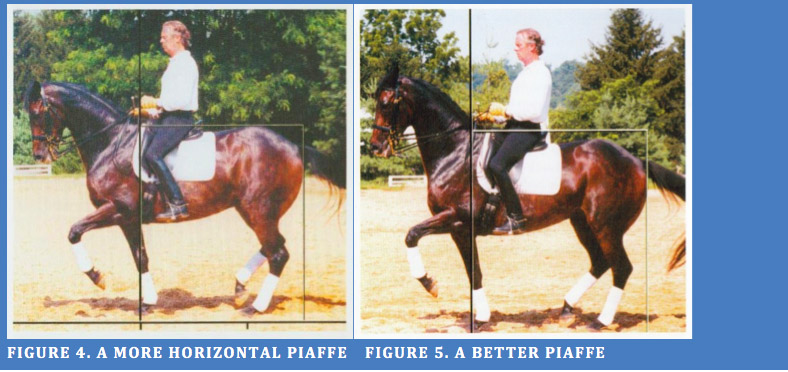
FIGURE 4. A MORE HORIZONTAL PIAFFE FIGURE 5. A BETTER PIAFFE
Shown these two photos for a brief study of the piaffe, and given a choice without gridlines, many people selected Figure 4 as a better piaffe. Now, some right-angle lines have been placed as guidelines and reference points. A plumb-line from the point of the rump shows the hocks engaged in both photos. However, the white horizontal line shows the croup to be lower than the withers in Figure 5. (In and of itself, this cannot be the sole requirement of a good piaffe.) A look at the placement of the standing foreleg in Figure 4. Shows that it is further backward toward the center of gravity than in the other photo. A vertical line from the foot intersects the edge of the saddle. This leg has crept back and is closer to its diagonal, planted partner, thus making the distance between the two grounded feet shorter. This is a more horizontally balanced piaffe, tending toward triangulation. The weight of the horse is not significantly borne by the hindquarters.
In Figure 5, the piaffe is of much better quality. A vertical line drawn up from the planted forefoot shows it is much more forward. The distance between the grounded pair of legs is longer as they are further apart. This is possible because the neck is raised higher (see the face now much more in front of the vertical). The topline is firmer, so the hind end can lever the forehand up. This piaffe shows the hindquarters carrying more weight and the forehand being lifted and lightened. This piaffe can turn into a levade as seen in Figure 6, which would show more classical collection and weight shift than that in Figure 4.
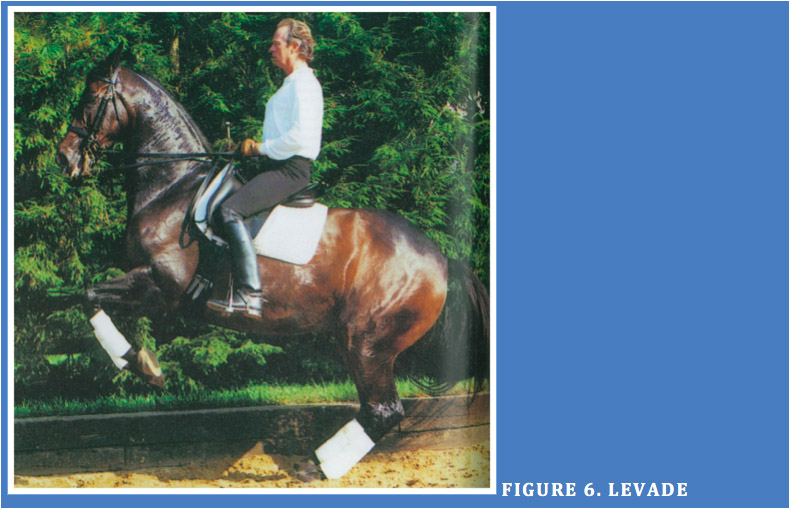
FIGURE 6. LEVADE
For more information, see my book Dressage for the 21stCentury, available at Xenophon Press.
There are more articles by Paul Belasik on this website:
http://www.horsemagazine.com/thm/2017/01/paul-belasik-why-are-fundamental-problems-persisting-in-elite-dressage/
Paul Belasik: Why are fundamental problems persisting in elite dressage? Part Two
see also:



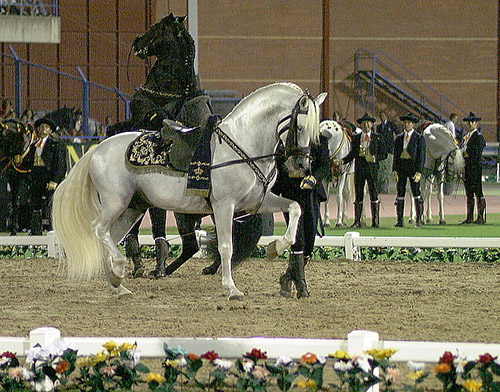
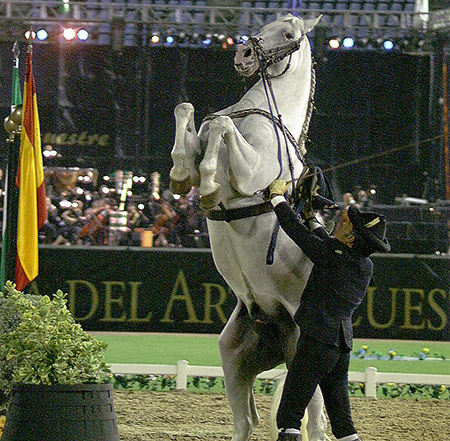
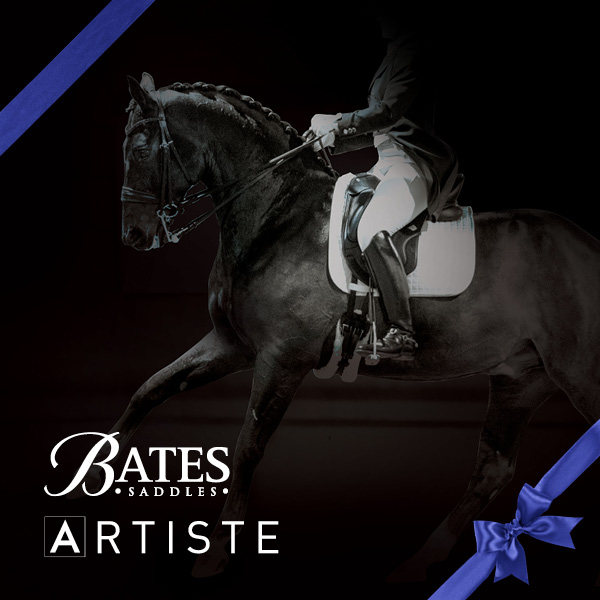
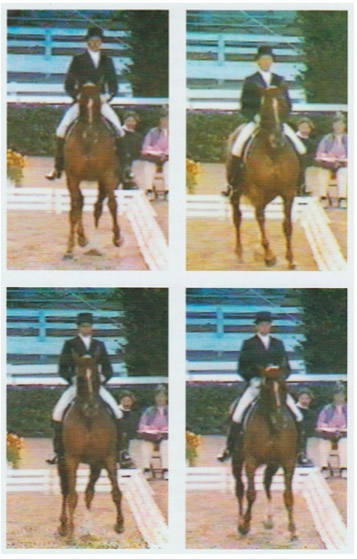
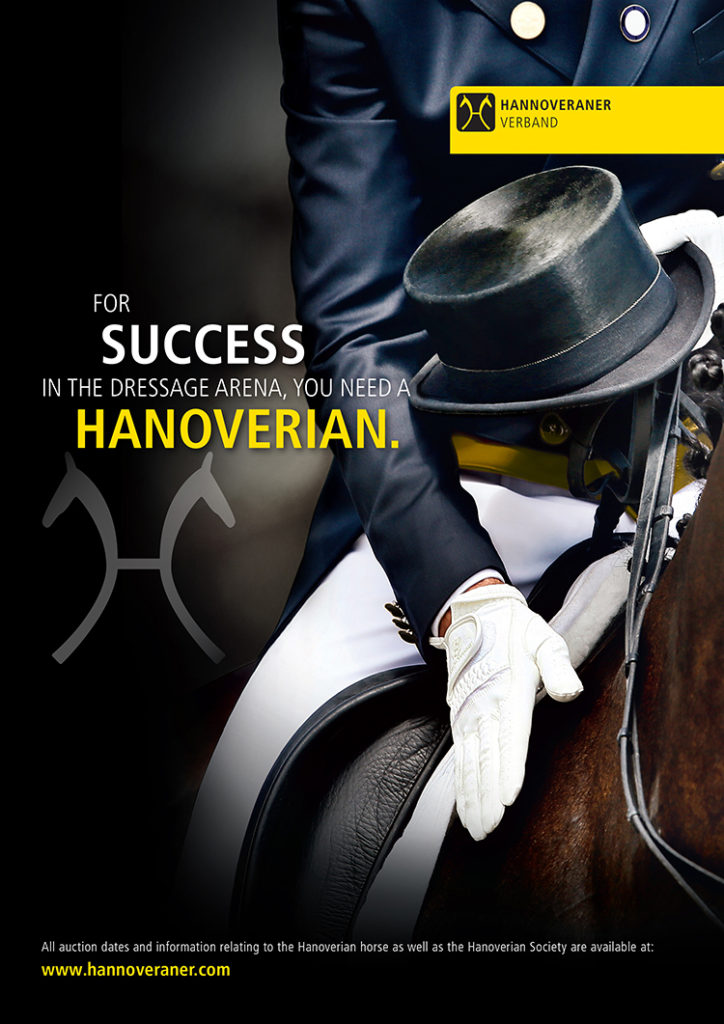
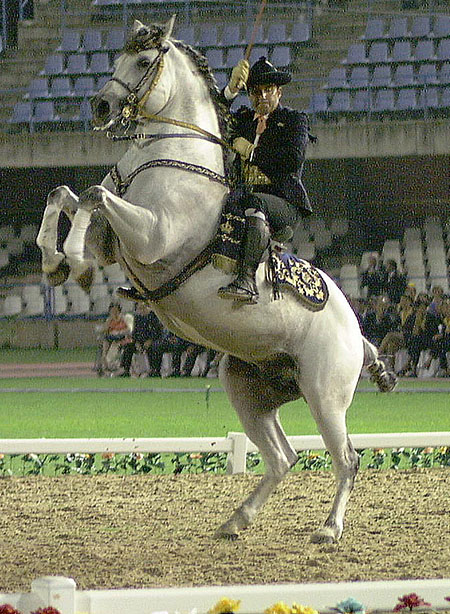
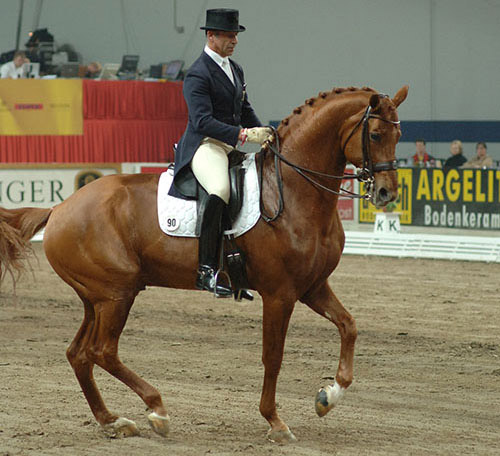
I enjoyed reading Your article on Piaffe & looking forward to April 25, 2020 clinic @ Pa. Riding Academy on back & seat usage, thank YOU, Doug